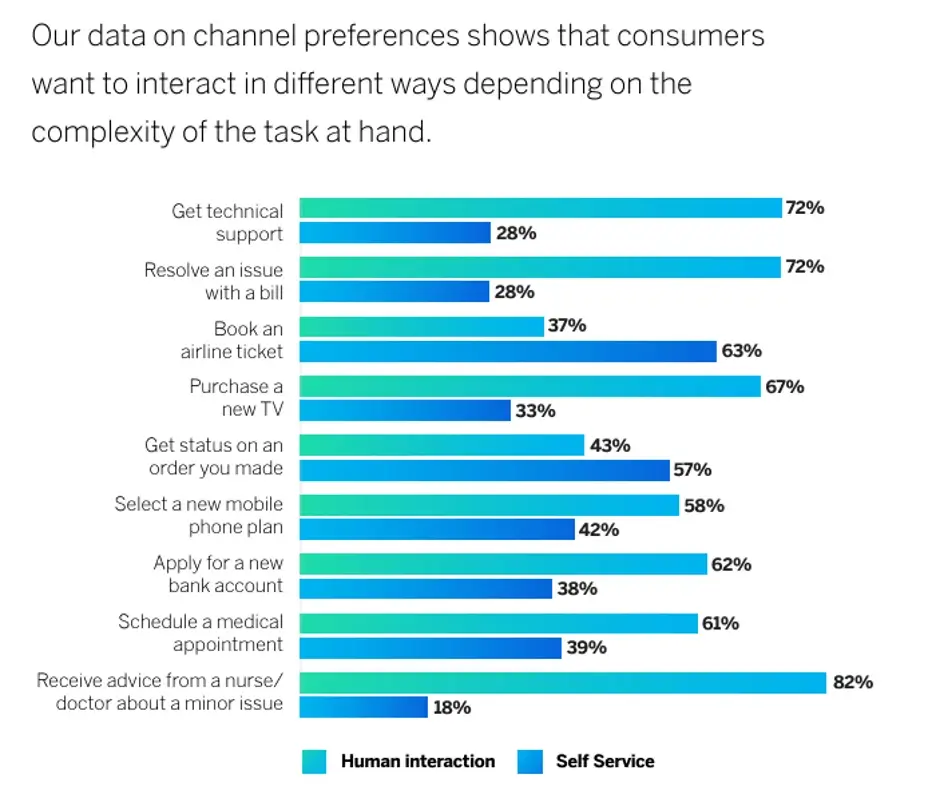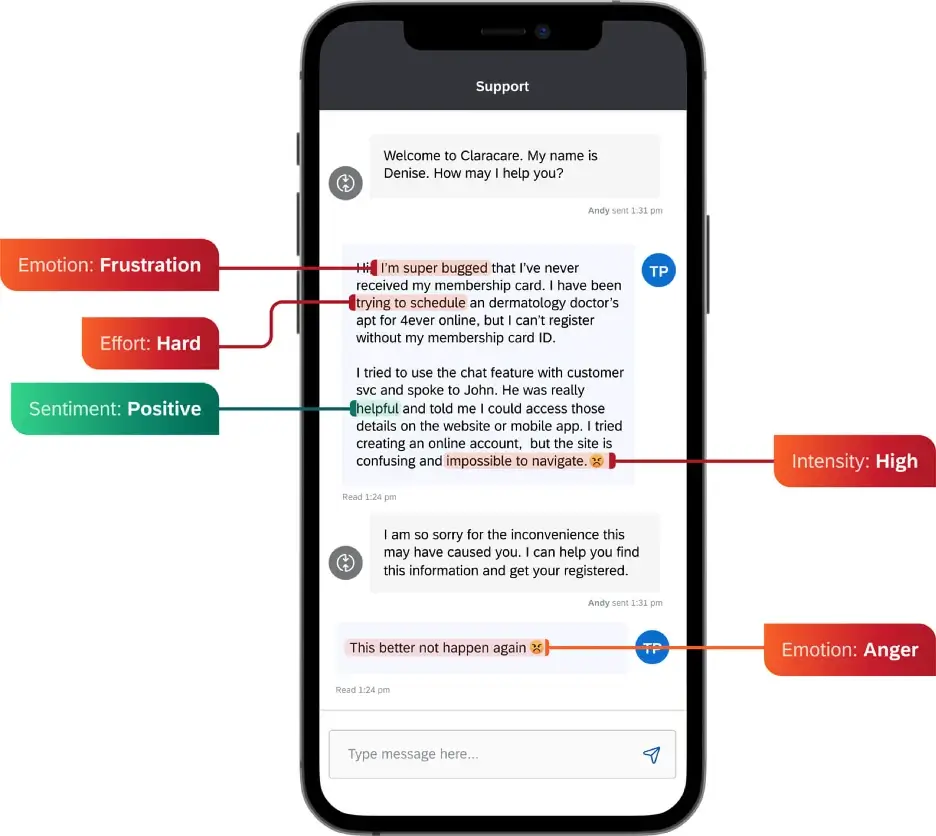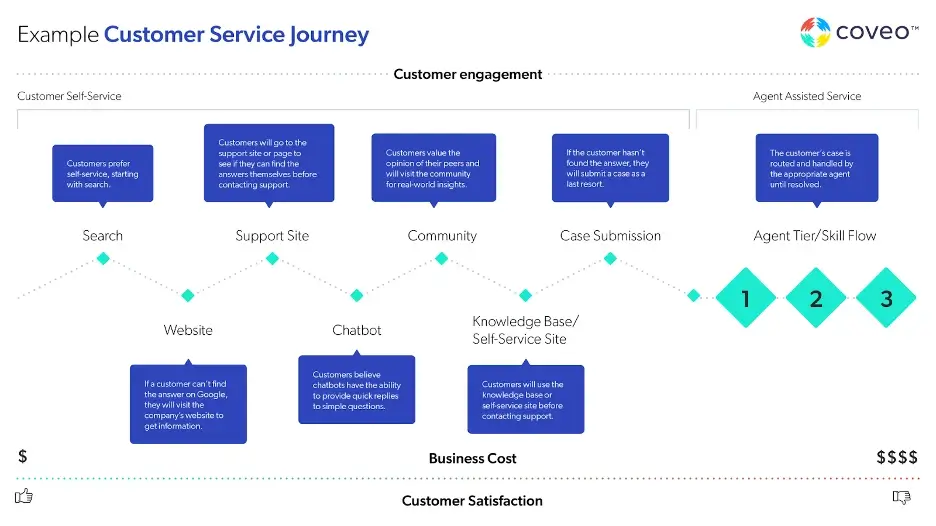Customer service can be expensive — particularly when there are people involved — and in some cases it can be a real effort on the customer’s part too, leading to frustration and potentially churn.
Over the past decade, more and more companies have looked to technology that enables customers to self serve and resolve their issue with as little effort as possible, all at a lower cost to the company.
But getting self service right is critical. If customers can’t get the support they need quickly, they’ll switch to another channel such as phoning your contact centre. Not only is that frustrating for them, but it costs the company more to serve them.
In this guide we’ll look at how customer self service works, when to use it (and when not to), and how to optimise the experience to help drive customer spend, loyalty, and advocacy.
Stop customer issues from becoming lost revenue with XM for Customer Fronlines
What is customer self service?
Self service is where customers carry out actions or tasks themselves, rather than getting in touch with an agent. It’s most commonly seen in customer support through tools like FAQs, support portals, and chatbots as well as in subscription businesses such as telcos where customers can usually log in and manage their account themselves.
Benefits of providing customer self service
There are benefits for both the customer and the organisation by adopting more customer self service touchpoints. Here are just a few:
Self service helps your customers by…
- Giving them a choice
Some customers feel comfortable using technology and find it easy to use— in fact many prefer it to talking face-to-face. 67% of customers prefer helping themselves instead of speaking with a customer service - XM Institute research has found that customers will choose to self serve for some tasks, while for others they still prefer to deal with it in person. In particular, low effort and non urgent tasks like checking delivery status or an account balance tend to be things people are happier to do themselves. On the flip side of that, complex or time sensitive issues are ones most people still prefer to do through human interaction.
- Reducing wait times
If every interaction needed to be carried out with human interaction, contact centres would be very, very busy. In fact, most large organisations would struggle to meet demand, and you’d have long wait times for customers who want to get in touch. When you think of the number of tasks that could easily be completed without human interaction, it’s easy to see how inefficient it is. - Lowering effort
Customer effort is a key part of the experience. If you can help customers achieve their goal with as little effort as possible, you’ll enjoy greater customer satisfaction and increase brand loyalty as a result. So having to phone, wait, explain their issue to an agent and walk through the process, self service options can massively reduce the burden on customers.
Self service helps your organisation by…
- Increasing cost efficiency
Every customer service agent you hire is an, if deployed correctly. When you can deflect simple customer queries to a self service portal instead of directing them to a support team, you free up your agents to focus on the more complex queries and tasks that only they can do. - Increasing flexibility
As the service can be carried out without in-presence employee support, services can be open 24/7 and customers won’t need to wait for business hours to complete a simple task. - Driving loyalty
We know reducing customer effort by measuring a customer effort score drives satisfaction, and satisfied customers are more loyal — so by making things easy for your customers you can have a direct impact on the bottom line as customers are happy to continue to work with you in the future.
To have the ability to share information immediately across every bank branch has enhanced transparency and changed the company culture. Now, managers are acutely aware of what customers need, and we are a much more customer-centreed organisation.
Customer self service examples
There are a whole host of ways you can help your customers get the answers they need quickly, without having to get your support team involved. Here are some of the most common ways to provide self service options to your customers:
FAQs
As a starting point, most customers will usually seek out a frequently asked questions (FAQs) page. This is a list of common questions that come up in support calls, or answer foundation questions (who, what, where, when, how and why) about your product or service.
The FAQ’s should cover answers to queries from across the customer journey, and be easy to navigate with simple search functionality to help people get the answers they need quickly.
Consider your FAQs as a dynamic site — always keep it updated with new questions or topics that arise in the contact centre. Similarly, if you notice a large volume or increase in calls about a particular topic, it could be worth revisiting your FAQs to ensure they are clear.
Knowledge base
Try creating a dedicated place on the website for support documentation or easy-to-search support articles. This content can be in a customer self service portal (see below) or as a separate website that is linked to from your main brand website.
Knowledge base articles are a free reference-style collection of technical information, which can come from all over the business, and is separated into themes or products. Customers can choose which areas to explore, to gain more information and understand more details. Relevant knowledge base articles can be recommended on product pages to help with customer product usage, for example.
Online community forum
Similar to a website knowledge base, online community forums can be a useful tool for customers to search through previous topics and questions. Customers can ask questions to the community and receive answers from other customers or support agents.
The questions and answers build a database that, over time, will cover a large proportion of the most common issues your customers face. It’s really efficient too, as if a customer has a query, it’s likely someone else has asked it before, so rather than using up your agents’ time answering the same questions over and over you can help customers find the answers in the community.
It’s important to tie any forum into your customer care tech stack too — customer support representatives should be able to respond to forum questions, and even take them offline to get in touch and close the loop. This is essential to help identify queries that would be better dealt with in person, and then reaching out directly rather than leaving a customer to get frustrated at not finding their answers from the community.
Product or skills training portal
Self service solutions such as product training how-to videos or physical ‘quick start’ guides can be added to the product’s webpage to give customers a self guided way of experiencing your product.
Chatbots
Live chat functions or chatbots are a quick and easy way for customers to reach out to get information. Common answers to questions are stored in the bot, where they can be brought into conversation by picking certain option buttons.
Bots save time for customers to search through records as the bot can interpret the question asked, draw out keywords and search for answers containing these. Complicated issues might need more help, so including an option to speak to an agent during the chat gives customers additional reassurance.
What is a customer self service portal?
Some of the examples above can be referred to as a customer self service portal, because it is a place (a web page or an additional site) where information is stored and available for searching. For example, a knowledge base or training area can be called a customer self service portal, as well as secure, authenticated sections of a company’s website where customers can access a personalised view of their products and services.
By design, it looks like part of the main brand webpage, but might have a separate web address or have a sub-page from the main brand URL web address. They may also have different systems connecting into the portal, that help capture data for CRM systems or inform customer support systems.
At Qualtrics, we have self service digital support portals like the Customer Support Portal, and Qualtrics XM Community. Check them out to see how they work!
Improving your customer self service strategy
In today’s market, customers are looking for self service that can anticipate their needs and meet them where they are. Depending on how complex a query is, your customers will have different preferences – so creating a self service strategy that can be everywhere and meet every need will require some careful planning.

Customer self service strategies in a digital age
Here are some strategic ideas for meeting customer expectations for self service in a digital age:
Use technology to your advantage
There’s a wealth of ways technology can transform your self service. For example, instant chat, SMS, mobile app and social media messaging can be streamlined with the use of artificial intelligence to automatically respond to customer requests. Your audience is looking for customer self service options on all channels – to avoid your customer service representatives having to be everywhere all the time, you can use technology to fill the gaps.
Machine learning can also help you to hone your automatically-generated responses and provide a better customer experience. With more data, your recommendations become more and more tailored to the point where specific customer requests are a breeze.
Natural Language Processing or Natural Language Understanding can also be used to help make your AI responses more “human” and to allow for greater search capabilities. When your customers search through your self service options, NLP or NLU can better interpret what they’re looking for and deliver the best answer.

Key into your data for customer self service journey optimisation
Your self service should be a constantly-evolving tool that best reflects your customers’ requirements. Your self service tools should be delivered at the right place, at the right time – and data analytics on your customer journey can help you to fulfil this need.

Your customer service journey is a guide to providing the right answers at the right time. You can smooth friction points, preventing customers from being lost by offering help that’s easy for them to access.
With your customer and operational data to hand and the right customer service software, you can easily translate journey insights into self service prompts for better customer experiences.
Ensure you deliver rapid responses
More than anything, a digital customer self service system should be fast. Self service tools should be available 24/7, with multiple avenues for responses. Your audience’s patience is limited – for example, 40% of Millennials will reach out on more than one contact channel if left waiting for a response for 1 hour – so the faster a response can be delivered, the better!
5 customer self service best practice tips
How can you do customer self service well? Follow these four tips to get you implementing changes with the right factors in mind:
1. Know when to deploy your customer service team
The first thing to get right is to understand which queries should be diverted to self service and which still need human interaction through a support team. While technology has come a long way to help improve self service channels, there are some queries your customer will prefer to speak or chat with a human about.
If the issue can’t be solved without human interaction, or if it involves too much effort for the customer, default to a human. The risk of frustrating customers and leaving them dissatisfied when they don’t complete a task is too great.
2. Use customer feedback to keep your content up to date
Whether it’s an FAQ, knowledge base article, or chatbot, you should measure how your self service content performs and constantly update it based on user feedback. Content effectiveness tools are a great way to better understand if users are getting what they need, and identifying what you need to do to improve it.
You can combine this with other sources of data such as web traffic, page views, and shares to identify which content is performing well, used frequently, and which doesn’t.
3. Always provide a ‘bail out’ option
Whether you think your customer self service options are great or not, the ultimate judge will always be the end user. Some might find your ‘manage my account’ portal easy enough, but others may struggle.
So on any pages for self service tools, provide an option to escalate the issue to another channel such as live chat or phone. That way those customers who don’t find it as easy to navigate will still have the option to complete their task.
4. Measure the effectiveness of digital support content and channels
How can you tell if your customer self service solution is working? You need to include a robust system for capturing the data from customer self service portals or initiatives, and interpret the results to see if customers are successfully serving themselves from start to finish.
There are plenty of different ways to measure it, including:
- customer satisfaction (CSAT) — how satisfied overall were they with the experience of your self-service portal.
- customer effort score (CES) — a key metric in digital customer experience, how easily were they able to complete the task.
- task completion — a simple yes or no question asking whether they were able to complete the task they came to complete
For both CSAT and CES you can ask follow up questions about specific touchpoints, or invite open text responses to dig deeper into the key drivers.This is useful in helping you to identify actions to take to improve the experience.
These measurements can also provide a trigger to follow-up with customers who either weren’t happy, who weren’t able to complete their task or who didn’t find what they were looking for from self service. If they need more help, you can trigger a follow up for a customer support agent to get in touch and help them.
Best practices: Find out how to use digital support to drive customer loyalty
5. Bring your customer support and self service together
A good digital customer experience platform is essential to optimising your customer self service. By integrating all your channels into a single tech solution, you’re able to get a holistic view of the customer experience.
We know customers ‘mix and match’ the channels they use and, if they can’t complete it through one, they’ll switch to another. So being able to track the entire journey, you’re able to see how they come together to deliver a holistic experience.
You can see where the experience falls down and needs improving, and where you’re having the biggest impact on the customer experience.
Trending topics coming into your contact centre can trigger an update to your FAQs or self-service portal to help people self-serve and reduce effort. And feedback and data on your self-service portals can be a trigger to up-skill support agents, training them in handling any new, or trending support topics from your digital channels.
Plus, because you can see the end-to-end journey, when a customer does switch from self-serve to your contact centre, your agents will have a record of their interactions, so they can meet them where they are and help resolve issues faster.
Using customer self service software
Great customer service is a learning process that takes into account how each aspect of your digital support is received and what else your customers are looking for. This is why having comprehensive customer self service software can help you to easily meet the ever-evolving demands of customers in a digital age.
Improve your customer experiences with digital support that’s effective and memorable.
Find out how to use digital support to drive customer loyalty